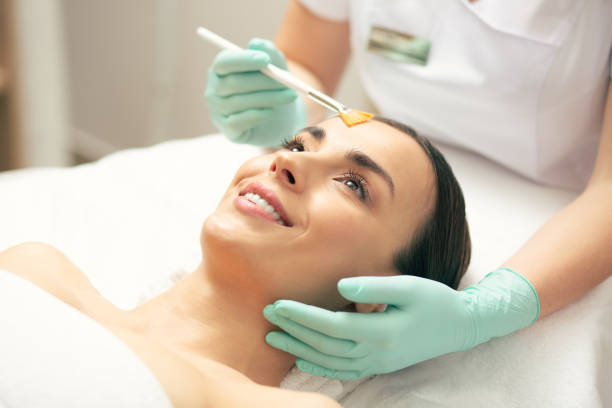Are you looking to revitalize and enhance your skin? Skin peels are a great option for achieving glowing, young-looking skin. They can help reduce the effects of sun damage, fine lines and wrinkles, acne scarring, hyperpigmentation, as well as various other skin imperfections. With so many different types of skin peels available today, it can be difficult to decide which type is best suited for your needs. In this blog post we will provide an in-depth guide on all matters related to how skin peels work and what each type has to offer! We hope this will help you make the right decision when looking into effective skincare solutions that give lasting results.
Page Contents
What are Skin Peels and How Do They Work
Our skin is the most exposed body part to different environmental factors such as sun rays, pollution, and stress. As a result, it is necessary to keep it rejuvenated. Skin peels is a technique used by dermatologists or aestheticians, which involves the application of a chemical solution to the skin that exfoliates and removes the top layer of dead skin cells. The technique varies based on the strength of the peel and is effective for different purposes such as reducing fine lines, age spots, acne, and hyperpigmentation. The procedure works by stimulating the production of collagen which is essential in keeping the skin firm and youthful. It is important to seek professional advice before undergoing the process, as different skin types require different approaches for effective results.
Types of Skin Peels
Skin peels are a popular cosmetic treatment that can improve the texture and appearance of your skin. There are different types of skin peels available, each with its own unique benefits. For instance, glycolic acid peels are good for reducing fine lines and wrinkles, while salicylic acid peels can help with acne-prone skin. Another type of skin peel is the Jessner Peel, which is a combination of salicylic acid, lactic acid, and resorcinol. This peel is effective in treating hyperpigmentation and sun damage. No matter what your skin concerns are, there is a skin peel out there that can help you achieve your desired results. It’s important to consult with a licensed skincare professional to determine which type of skin peel is right for you.
a. Alpha Hydroxy Acids (AHAs)
Alpha Hydroxy Acids, or AHAs, are a group of natural or synthetic acids used in skincare products. These potent ingredients work by exfoliating the top layer of skin to reveal a brighter, smoother complexion. AHAs are known for their ability to turn over dead skin cells, unclog pores, and stimulate collagen production. Some of the most commonly used AHAs include glycolic, lactic, and citric acid. However, it’s important to note that not all skin types can handle AHAs, so it’s best to start with a lower concentration and gradually increase over time. With regular use, AHAs can help improve uneven texture, hyperpigmentation, and fine lines. Incorporating AHAs into your skincare routine can be a game changer for achieving glowing, healthy-looking skin.
b. Beta Hydroxy Acids (BHAs)
Beta Hydroxy Acids, or BHAs as they are commonly referred to, are a type of chemical exfoliant that has been all the rage lately in the skincare world. Unlike Alpha Hydroxy Acids (AHAs), which are best suited for those with dry or sensitive skin, BHAs are ideal for those who struggle with oily or acne-prone skin. BHAs work by penetrating deep into the pores, dissolving excess sebum and dead skin cells that can lead to breakouts, leaving your skin looking smooth and radiant. If you’re someone who’s been struggling to get rid of stubborn acne or blackheads, incorporating a BHA into your skincare routine might just be the solution you’ve been searching for!
c. Retinols
As we age, our skin goes through a natural process of losing its elasticity, leading to the formation of wrinkles and fine lines. This is where retinols come into play. Retinols are a type of vitamin A derivatives that help improve the skin’s overall appearance by reducing signs of aging, discoloration, and acne marks. Not only do they boost collagen production, making the skin appear plumper, but they also increase cell turnover, resulting in smoother and brighter skin. Retinols can be found in over-the-counter skincare products, and it is advised to start with a lower concentration to avoid irritation and build up to higher concentrations over time. With consistent and proper use, retinols can help you achieve a more youthful and radiant complexion.
Benefits of Skin Peels
Skin peels are an excellent way to rejuvenate your skin and improve its appearance. These treatments help to exfoliate dead skin cells while stimulating new cell growth, resulting in a brighter, smoother complexion. Not only do they address fine lines and wrinkles, but skin peels can also help to reduce the appearance of acne scars and age spots, leaving you with a clearer and more youthful-looking complexion. What’s more, the benefits of skin peels extend beyond the surface – they can also boost collagen production and enhance hydration levels, leaving your skin feeling supple and hydrated. With so many benefits, it’s easy to see why skin peels have become popular among those looking to achieve a more youthful, radiant complexion.
Safety Tips for Using Skin Peels
Skin peels are a popular way to rejuvenate your skin by sloughing off the top layers to reveal younger, smoother-looking skin beneath. However, using skin peels incorrectly or haphazardly can lead to skin irritation, burns, or even scarring. That’s why it’s important to follow these safety tips for using skin peels. Always start with a patch test to ensure that you don’t have an allergic reaction or sensitivity to the product. Use the right strength for your skin type and condition, and don’t leave the peel on for longer than recommended. Be sure to avoid sun exposure, wear protective clothing, and use SPF while your skin is peeling. With these safety measures in mind, you can enjoy the benefits of skin peels while minimizing the risk of adverse reactions.
Best Practices for Effective Skin Peel Treatments
Achieving healthy, glowing skin is a popular goal, and there are a variety of ways to get there. One method that has gained popularity in recent years is skin peels. This treatment involves applying a chemical solution to the skin, which exfoliates and removes the top layer of dead skin cells, promoting cell turnover and revealing fresh, smooth skin underneath. However, it is important to approach skin peels with caution and utilize best practices to ensure safety and effectiveness. This may include choosing the appropriate type of peel for your skin type, properly prepping and caring for your skin before and after the treatment, and seeking the expertise of a licensed skincare professional. When done correctly, skin peels can be a great addition to your skincare routine for achieving radiant, healthy skin.
How to Choose the Right Skin Peel for Your Needs
When it comes to choosing the right skin peel for your needs, it can be overwhelming to navigate the different options available. The first step is to identify your skin concerns, whether it be dark spots, fine lines, or acne. From there, do your research on the types of peels available, including chemical peels and enzyme peels. Consider the strength of the peel and your skin type, as some peels can be too harsh for sensitive skin. It’s also important to take into account the downtime required for the peel, or using rehydration serums as some may require multiple days of recovery. Ultimately, consulting with a dermatologist or licensed aesthetician can provide valuable insight and personalized recommendations. By taking these factors into consideration, you can confidently choose the right skin peel for your unique skin needs.
In conclusion, understanding the different types of skin peels, their benefits, and proper safety tips when using them is essential to determine the right skin peel for your needs. Skincare is imperative for healthy and flawless-looking skin. Skin peels are great ways to exfoliate dead cells and invigorate your skin giving it a beautiful glow. Regular use of AHAs, BHAs and Retinols peels will lead to improved collagen production which can help reduce fine lines, crow’s feet wrinkles, acne breakouts, and blemishes while leaving healthier more radiant skin. For those considering getting professional treatment or those that plan to use do-it-yourself products, it’s important you understand how they work and what can help you achieve best results.
Knowing your products as well as following correct application instructions will ensure safe and effective treatments. Doing research in advance about the type of product available on the market can help you select one suitable for you and your lifestyle. Remember consistency is key to achieving desirable results when using skin peels so make sure you follow a routine that works best for you designed specifically by the skincare specialist or dermatologist that fits both your lifestyle and desired outcome until successful results are seen!

Lois Lane is a professional blogger and a seasoned Content writer for wellhousekeeping.com. With a passion for simplifying complex Home Decor topics, he provides valuable insights to a diverse online audience. With four years of experience, Lois has polished his skills as a professional blogger.




